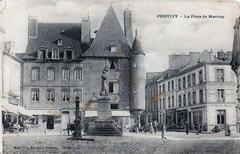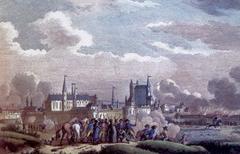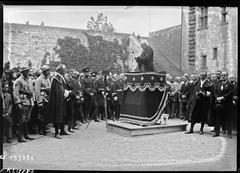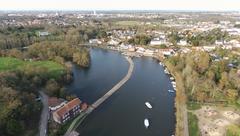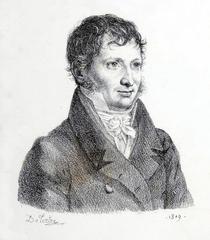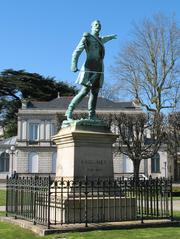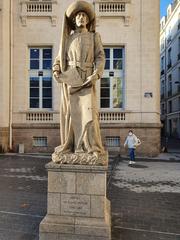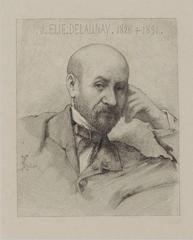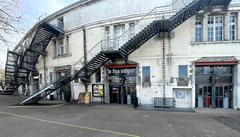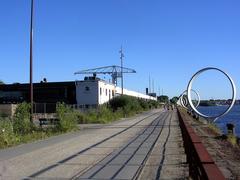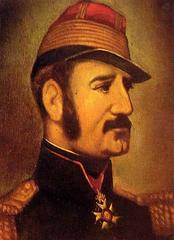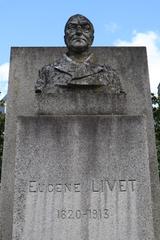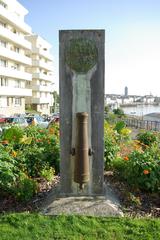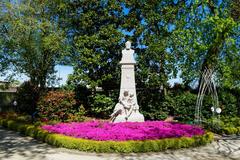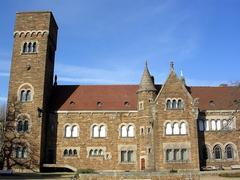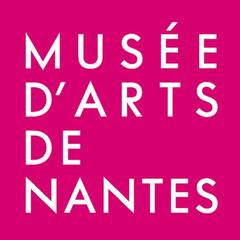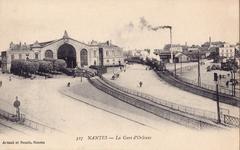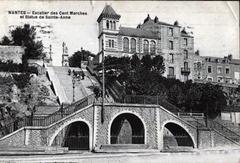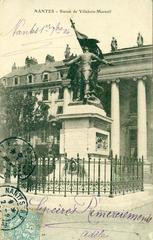Rue Baptiste-Marcet Nantes: Visiting Hours, Tickets, and Historical Sites Guide
Date: 14/06/2025
Introduction
Located in the western districts of Nantes, France, Rue Baptiste-Marcet provides visitors with an authentic glimpse into the city’s rich past and vibrant present. While it is primarily a residential street without formal visiting hours or ticketing, its strategic position in the Chantenay and Dervallières-Zola neighborhoods makes it an excellent base for exploring Nantes’ celebrated cultural heritage. Proximity to major attractions like the Château des Ducs de Bretagne and the innovative Machines de l’Île further enhances its appeal.
This comprehensive guide delves into the street’s historical context, urban evolution, contemporary character, and practical visitor information. Whether you are an explorer of history, a seeker of local experiences, or simply seeking convenient access to Nantes’ top attractions, this article equips you with all the details you need for a rewarding visit.
Useful resources for further planning include Simply France and the official Nantes tourism website.
Table of Contents
- Historical Foundations and Urban Development
- Contemporary Neighborhood Profile
- Landmarks and Nearby Attractions
- Visitor Information and Practical Tips
- Frequently Asked Questions (FAQs)
- Conclusion
- References
Historical Foundations and Urban Development
Medieval and Early Modern Context
Rue Baptiste-Marcet is set within neighborhoods that bear the imprint of Nantes’ medieval and early modern history. During the Middle Ages, Nantes rose as a vital port city along the Loire River, drawing traders from across Europe. Expansion westward from the city center laid the groundwork for Chantenay and Dervallières-Zola, precursors to the vibrant urban fabric that surrounds Rue Baptiste-Marcet today (Simply France).
The 13th–15th centuries saw Nantes thrive as the capital of the Duchy of Brittany, marked by the construction of the Château des Ducs de Bretagne and the Cathedral of St. Peter and St. Paul. While Rue Baptiste-Marcet itself is a more recent creation, its surroundings were shaped by the city’s economic and population growth during this era.
Industrial Transformation
The 19th century brought sweeping changes as Nantes embraced industrialization. Chantenay, annexed by Nantes in 1908, evolved from a semi-rural enclave into an industrial suburb, home to factories, shipyards, and worker accommodations. This transformation fostered the development of residential streets like Rue Baptiste-Marcet, with a legacy that endures in the area’s built environment and community spirit (About-France.com).
Following World War II, as heavy industry declined, the area transitioned to a more residential profile. Urban renewal improved housing and public services, attracting a diverse population and enhancing the quality of life (Nestenn Real Estate).
Contemporary Neighborhood Profile
Real Estate and Community Life
Today, Rue Baptiste-Marcet is a peaceful, family-oriented street characterized by mid-century homes and apartment buildings. Property values reflect a diverse housing market, with recent prices ranging from €2,344 to €5,159 per square meter. Notable sales include a 92 m² house for €430,000 and a 44 m² apartment for €134,000 (Nestenn Real Estate).
Amenities and Accessibility
The street and its surroundings offer excellent amenities: schools, local shops, healthcare services, and parks. Public transport is efficient and well-integrated, with tram and bus lines providing easy access to the city center and major attractions (OpenAlfa, France Travel Planner). The neighborhood is safe, walkable, and welcoming to families and visitors alike.
Landmarks and Nearby Attractions
Château des Ducs de Bretagne
Overview: This iconic 15th-century fortress served as the residence of the Dukes of Brittany and now houses the Nantes History Museum, offering immersive exhibits on the city’s past.
- Visiting Hours: Tuesday to Sunday, 10:00 AM – 6:00 PM; closed Mondays and public holidays.
- Tickets: Adults €8, reduced €5, free for under 18s. Family pass available.
- Guided Tours: Offered in French and English; book in advance.
- Accessibility: Wheelchair-accessible, with ramps and elevators.
- Amenities: Gift shop, café, restrooms.
- Official Information: Château des Ducs de Bretagne
Machines de l’Île
A unique cultural and artistic park inspired by Jules Verne and Leonardo da Vinci, featuring giant mechanical animals and rides.
- Visiting Hours: Typically 10:30 AM – 7:00 PM (seasonal variations).
- Tickets: €9–€12 for adults; discounts for children and Nantes Pass holders.
- Events: Interactive rides and seasonal shows.
- Official Site: Les Machines de l’Île
Nantes Cathedral (Cathédrale Saint-Pierre et Saint-Paul)
A stunning Gothic cathedral open daily (8:00 AM – 7:00 PM), free to enter, and notable for its grand architecture and stained glass windows.
Passage Pommeraye
This 19th-century arcade is a top shopping and architectural destination, open during shop hours but accessible as a walkway at all times.
Visitor Information and Practical Tips
Getting There
- Tram: Line 1 (Tertre stop, 8 minutes’ walk), connects to the city center.
- Bus: Lines 11, 23, 91, C20, and C3 serve the neighborhood.
- Train: Chantenay station connects regionally via line P12.
- Bicycle: Bicloo, Nantes’ bike-sharing scheme, offers convenient rentals.
Tickets and Passes
- Nantes Pass: Unlimited public transport and free or discounted entry to attractions.
- Transport: TAN network tickets valid for one hour, available via machines or the TAN app.
- Weekend Tip: Public transport is free on weekends.
Food and Drink
Local cafés and bakeries offer casual dining. Broader culinary options are available in the city center and at the Talensac market (Lonely Planet).
Accommodation
While Rue Baptiste-Marcet itself lacks hotels, the adjacent city center features a wide range of options from hostels to boutique hotels (Le Voyage à Nantes).
Accessibility and Safety
The area is safe, quiet, and wheelchair-friendly, with low-floor trams and accessible sidewalks.
Cultural Etiquette
Greet shopkeepers with “Bonjour;” tipping is optional but appreciated. Participate in local festivals, such as the summer Le Voyage à Nantes festival.
Essential Contacts
- Nantes Tourism Office: Le Voyage à Nantes
- Emergency: 112
Frequently Asked Questions (FAQs)
Q1: Is Rue Baptiste-Marcet a tourist attraction with visiting hours or tickets?
A1: No, it is a residential street but offers convenient access to major attractions nearby.
Q2: How do I reach the Château des Ducs de Bretagne from Rue Baptiste-Marcet?
A2: Take Tram Line 1 from Tertre stop to Commerce; the castle is a short walk from there.
Q3: Are guided tours available at nearby monuments?
A3: Yes, key sites like the Château des Ducs de Bretagne and Machines de l’Île offer guided tours.
Q4: Is the area safe and family-friendly?
A4: Yes, the neighborhood is considered safe and welcoming to families.
Q5: How can I save on transportation and attraction tickets?
A5: Use the Nantes Pass for unlimited transport and discounted or free admission to many sites.
Conclusion
Rue Baptiste-Marcet exemplifies the transformation of Nantes from a medieval port to a lively, welcoming city. While not a formal tourist site, its real charm lies in its authentic neighborhood atmosphere, comprehensive amenities, and easy access to Nantes’ historical heart. With excellent public transport and proximity to landmarks like the Château des Ducs de Bretagne and Machines de l’Île, the street offers both visitors and residents a gateway to the best of Nantes’ culture and history.
For the latest updates, guided tours, and interactive experiences, use the Audiala mobile app and consult official resources such as Le Voyage à Nantes and Château des Ducs de Bretagne.
References and Further Reading
- The Rich History of Nantes – Simply France
- Rue Baptiste-Marcet Property Data – Nestenn Real Estate
- Official Nantes Tourism Site – Le Voyage à Nantes
- Rue Baptiste-Marcet Services – OpenAlfa
- Nantes Transportation Information – France Travel Planner
- Château des Ducs de Bretagne Visitor Information – Nantes Tourism
